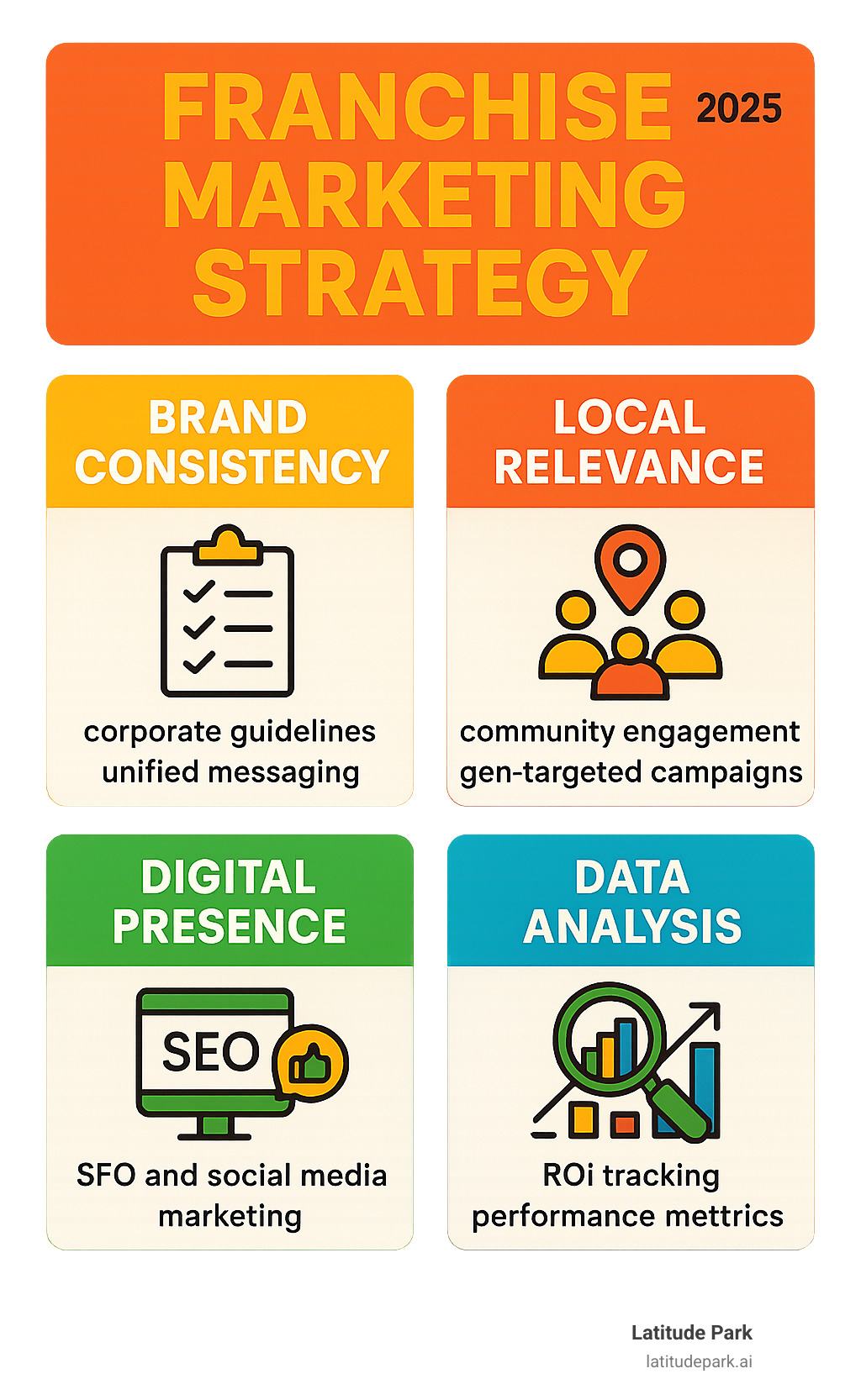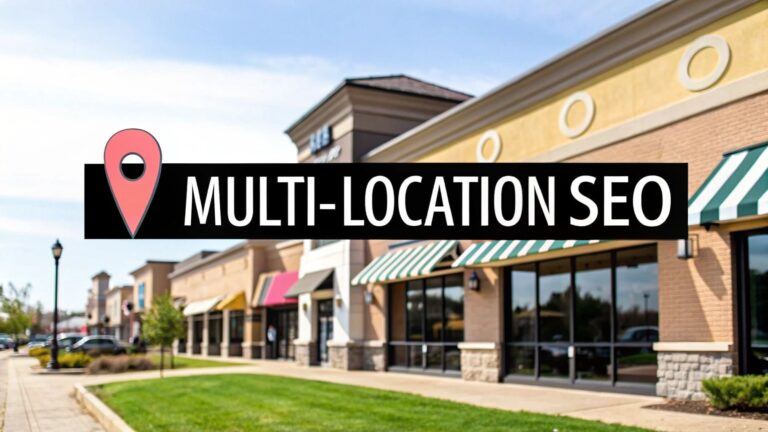Why Franchise Marketing Manager Tips Are Critical for Multi-Location Success
Franchise marketing manager tips are essential for coordinating successful campaigns across multiple locations. The core challenge is balancing brand consistency with local relevance. Franchisors must protect their brand while empowering franchisees to connect with their communities. This requires clear communication, shared strategies, and the right digital marketing tools.
With over 806,270 franchises in the United States generating more than $800 billion annually, an effective marketing strategy is non-negotiable. Key strategies include:
- Balancing Brand and Local: Maintain corporate guidelines while allowing local customization.
- Mastering Digital Channels: Focus on local SEO, social media, and targeted email.
- Managing Online Reputation: Proactively handle reviews and encourage positive feedback.
- Using Data-Driven Planning: Track ROI and other key performance indicators (KPIs).
- Solving Common Challenges: Address franchisee buy-in, budget constraints, and compliance.
- Leveraging PR and Influencers: Build authentic community connections.
- Implementing Proper Tools: Use CRM, asset management, and analytics dashboards.
As Rusty Rich, President and founder of Latitude Park, I’ve spent over 15 years helping franchises build strong online presences. My experience has shown that successful franchise marketing requires both strategic vision and operational discipline to coordinate campaigns effectively across all locations.

1. Master the Balance Between Corporate Brand and Local Flavor
One of the most difficult tasks in franchise marketing is balancing a consistent brand with local relevance. The corporate brand provides the recognizable foundation, while franchisees add the local flair that connects with the community. Both are essential for success.
Franchises thrive on an established brand and proven systems. However, the core challenge remains: maintaining a unified brand while allowing for local adaptation. For more insights, explore The Power of Consistent Branding Across Franchise Locations.
Establishing Unbreakable Brand Consistency
Corporate-led marketing sets the stage by defining and enforcing a clear brand identity. This is achieved through comprehensive style guides that dictate everything from logos and color schemes to font choices, image styles, and the brand’s tone of voice. Think of an Arby’s in Kansas City looking and feeling exactly the same as one in Toronto—that’s brand consistency.
By providing these detailed guidelines, franchisors ensure every location projects a unified image. This builds customer trust and saves franchisees time and money by providing ready-to-use marketing materials.
Empowering Franchisees with Local Marketing Autonomy
While corporate sets the foundation, franchisees understand their local audience. Empowering them to tailor marketing efforts is key. This includes:
- Local Audience Targeting: Franchisees can analyze local customer preferences to customize campaigns, such as creating displays based on local needs or developing localized video ads.
- Community Engagement: Participating in local events, sponsoring sports teams, or collaborating with other local businesses builds strong community ties and shows the franchise is part of the local fabric.
- Geo-Targeted Promotions: Using tools like geo-fencing allows franchisees to reach relevant customers in their specific territory and manage competition from neighboring locations.
The balance between corporate oversight and local flexibility requires trust and open communication. Franchisors must educate franchisees on marketing plans and equip them with the necessary tools and relevant materials. To learn more, read Franchise vs. Corporate Marketing: How to Balance Brand and Local Strategy.
2. Build a High-Performance Digital Marketing Engine
In today’s digital-first world, a high-performance digital marketing engine is essential for survival. With over half of social media users researching brands on Facebook and Instagram and approximately 50% of shoppers using Google to find new products, an online presence is not optional.
Digital marketing for franchises perfectly blends corporate strategy with local execution. A well-oiled digital engine supports national brand recognition and hyper-local customer acquisition. The key is an integrated approach that leverages local SEO, social media, and email marketing to capture customers at every stage of their journey.
For a deeper dive, explore Digital Marketing Strategies for Franchises: Maximizing Online Success and understand the Importance of Digital Presence for Franchises 2025.
Dominate Local Search with a Multi-Location SEO Strategy
When someone searches “pizza near me,” your franchise must appear first. Local SEO is critical for this.

- Google Business Profile (GBP): Each location needs a fully optimized GBP with accurate contact info, hours, photos, and active review management. 64% of consumers use GBP to find contact details for local businesses.
- Location-Specific Keywords: Instead of broad terms like “Italian restaurant,” a Chicago location should target “Italian restaurant River North.” This tells search engines exactly who and where you serve.
- Website Optimization: Each location needs a dedicated, mobile-friendly landing page on the main website with locally relevant information.
- Online Directory Consistency: Ensure your business information is accurate and consistent across all platforms like Yelp and TripAdvisor to avoid confusing search engines and customers.
Learn more about SEO for Franchise Websites to ensure your locations rank high in local searches.
Harness the Power of Social Media for Community Building
Social media is where your franchise’s personality shines, allowing you to build genuine connections with your local community. With 68% of consumers following brands on social media to learn about new products, the opportunity is massive.
- Platform Strategy: Use Facebook location pages, connected to the main brand page, to allow for hyper-local content while maintaining corporate branding. Meta’s Ad Manager includes features specifically for managing multiple franchise locations.
- Localized Content: Encourage locations to share photos of their local team, community involvement, and location-specific events.
- User-Generated Content (UGC): Amplify authentic customer photos and stories. UGC builds trust in ways traditional advertising cannot.
- Paid Social Campaigns: Use geo-targeted ads to reach people within a specific radius of each location, and retargeting campaigns to bring back website visitors.
Explore how we help franchises achieve Franchise Social Media Growth and maximize their Meta Campaigns Franchise Growth.
Drive Loyalty and Sales with Strategic Email Marketing
Email marketing is the most cost-effective digital channel, delivering an ROI of $36 for every $1 spent. The secret is strategic segmentation and personalization.
- Segmentation: Group email lists by location, purchase history, and engagement levels to send highly relevant messages.
- Corporate Templates: Provide professionally designed, mobile-friendly templates that franchisees can customize with local details and promotions.
- Automation: Use automated campaigns like welcome series, birthday rewards, and re-engagement emails to maintain consistent communication without constant manual effort.
- Local Promotions: Announce grand openings, seasonal offers, and community events via email to provide immediate value to subscribers.
These franchise marketing manager tips for digital marketing create a comprehensive engine that works 24/7 to attract, engage, and convert customers.
3. Turn Online Reputation into Your Strongest Sales Tool
Your online reputation is one of your most powerful marketing tools. With nine out of ten customers reading online reviews before buying a product, what people say about you online directly impacts sales. These authentic customer voices carry more weight than any polished marketing campaign.
For franchises, the effect is compounded. Glowing reviews for one location strengthen the entire brand, while negative reviews can spread just as quickly. That’s why proactive reputation management is crucial. We help franchises strengthen the organization’s reputation by turning every customer interaction into a brand-building opportunity.
Proactively Manage and Respond to Customer Reviews
Managing online reviews is about building relationships in public. Your responses show potential customers how you treat people.

We focus on monitoring all major platforms—Google, Yelp, Facebook—and responding within 24 hours. For positive reviews, we express gratitude. For negative reviews, we respond with empathy, take responsibility, and offer solutions. A thoughtful response to a negative review can often impress potential customers more than a dozen positive ones.
Consistent customer care across all locations requires clear response templates and training. This ensures a cohesive brand experience, no matter which franchisee manages the local response.
Encourage and Leverage Positive Feedback
Generating a steady stream of positive reviews is a powerful growth strategy. Most satisfied customers won’t leave a review unless prompted.
- Review Generation: Use post-visit emails or QR codes on receipts to make leaving a review easy for customers.
- Customer Surveys: Use surveys to gather feedback and identify your happiest customers. Follow up with a personalized request for a public review.
- Social Proof Integration: Showcase glowing reviews on your website, in social media content, and in email campaigns. Seeing authentic praise from real people builds trust faster than any corporate message.
Strong online reputations also support Franchise Lead Generation Strategies by building credibility with potential franchisees. By turning customer feedback into a sales tool, you create a self-reinforcing cycle of growth.
4. Create a Comprehensive, Data-Driven Marketing Plan
A data-driven marketing plan is the GPS for your franchise’s growth. It ensures every marketing dollar is spent effectively. The best franchise marketing manager tips emphasize making informed decisions based on real data and clear objectives, not gut feelings.
Key components of a winning franchise marketing plan
Building a winning plan starts with a solid foundation:
- Target Audience Personas: Understand the demographics, behaviors, and motivations of your ideal customers and potential franchisees.
- Competitive Analysis: Know what your national and local competitors are doing well, where they fall short, and what makes your franchise different.
- Channel Strategy: Invest your time and money where your target audience spends their time.
- Content Calendar: Keep your messaging consistent and engaging across all channels and locations.
- Promotional Offers: Time promotions strategically to drive specific actions, like first-time visits or repeat purchases.
- Goal Setting and KPIs: Set specific, measurable goals, such as “increase customer acquisition by 25% in Q2.”
For more insights on budgeting, check out our Franchise Marketing Budget Tips.
Actionable franchise marketing manager tips for data analysis and ROI
Turning numbers into actionable insights is where the magic happens. Focus on the metrics that matter most for your franchise’s success.
- Customer Acquisition Cost (CAC): Know how much you’re spending to acquire each new customer through different channels.
- Lifetime Value (LTV): Understand the long-term revenue a customer generates. Your LTV should significantly outweigh your CAC.
- Conversion & Click-Through Rates: Measure how well your marketing messages resonate and compel action.
- Attribution Modeling: Understand the different touchpoints in the customer journey to invest in the right marketing mix.
We track results continuously to adapt strategies in real-time and optimize performance. The table below shows how key metrics differ based on your objective:
| Metric Category | Brand Awareness Focus | Lead Generation Focus |
|---|---|---|
| Reach & Visibility | Reach (unique viewers), Impressions (total views), Website Traffic (new vs. returning) | Leads Generated (new inquiries), Conversion Rate (leads to customers), Cost Per Lead (CPL) |
| Engagement | Social Media Engagement (likes, shares, comments), Brand Mentions (online and offline) | Customer Acquisition Cost (CAC), Return on Ad Spend (ROAS) |
| Impact | PR Coverage (media mentions) | Sales Revenue Attributed to Marketing, Lifetime Value (LTV) of Customers |
A data-driven approach ensures every marketing dollar contributes to measurable growth.
5. Overcome Common Problems with These Franchise Marketing Manager Tips
Managing marketing for a franchise network comes with unique challenges, but they are all solvable. The most common issues include franchisee buy-in, budget limitations, lack of resources, and rogue marketing that doesn’t align with brand guidelines.

Recognizing these challenges as part of the landscape is the first step. With the right approach, you can turn these obstacles into opportunities for stronger collaboration and better results. For a comprehensive look, see 9 Common Franchise Marketing Mistakes and How to Avoid Them.
Solving the Franchisee Buy-In and Budget Puzzle
Getting franchisees to invest in marketing requires a clear demonstration of value. Here’s how to do it:
- Prove ROI: Show franchisees concrete data from other locations. When they see that a specific strategy increased foot traffic by 35% for a peer, they’re more likely to participate.
- Establish Two-Way Communication: Use monthly webinars or dedicated Slack channels for franchisees to share feedback and ask questions.
- Use Co-op Advertising Programs: When corporate matches a portion of a franchisee’s local marketing spend, it makes investment more accessible and shows you’re a partner in their success.
- Offer Tiered Support: Provide different levels of support based on a franchisee’s resources and experience. New franchisees may need more hands-on help, while established operators can handle more sophisticated campaigns.
Essential franchise marketing manager tips for ensuring compliance
Brand consistency doesn’t have to be restrictive. The key is to make compliance easy.
- Centralized Asset Library: Create a one-stop shop for approved logos, photos, social media templates, and other marketing materials. This reduces the likelihood of off-brand content.
- Streamlined Approval Workflows: Implement a quick and easy process for franchisees to submit local marketing ideas for review. The goal is to enable success while protecting the brand.
- Ongoing Training and Education: Use bite-sized training modules and video tutorials to explain brand guidelines and showcase success stories.
- Regular Audits as Support: Frame audits as helpful check-ins to celebrate successes and identify opportunities, rather than punitive inspections.
By addressing these challenges proactively, you transform your franchise network into a collaborative marketing powerhouse.
6. Integrate Powerful PR and Influencer Strategies
Beyond paid ads, public relations (PR) and influencer marketing build authentic connections and earned media that customers trust. When a local news source or a neighborhood blogger features your franchise, it carries more weight than a banner ad. These strategies make your brand feel like a genuine part of the community.
For more cutting-edge approaches, explore our guide on Innovative Franchise Marketing Strategies 2024.
Building Local Buzz with PR and Community Partnerships
Effective PR is about authentically sharing your franchise’s story and demonstrating your commitment to the community.
- Local Media Outreach: Build genuine, ongoing relationships with local newspapers, radio hosts, and TV news producers to become a go-to source for stories.
- Compelling Press Releases: Craft narratives around local entrepreneurs, new jobs, or community impact instead of just announcing business updates. The International Franchise Association emphasizes how community involvement strengthens the franchising model.
- Event Sponsorships: Sponsoring a local charity run, school fundraiser, or festival increases visibility and shows your investment in the community’s success.
- Charity Partnerships: Align your brand with causes that matter to your local customers to create a powerful emotional connection.
Tapping into Local Influencers for Authentic Reach
The real power for local franchises lies with micro-influencers—trusted community voices with smaller but highly engaged followings.
- Identify the Right Influencers: Look for local personalities whose values align with your brand and whose followers match your target customers.
- Create Authentic Experiences: Instead of just paying for posts, invite influencers to genuinely try your products, attend events, or collaborate on community initiatives. This generates content that feels real because it is.
- Use Product Seeding: Create opportunities for influencers to naturally find and share what makes your location special, such as inviting a local fitness influencer to try your healthy menu options.
- Trackable Affiliate Codes: Measure the direct impact of influencer partnerships while giving their followers exclusive benefits, reinforcing the authentic relationship.
By integrating PR and influencer strategies, franchises create a web of community connections that drive both immediate sales and long-term brand loyalty.
Frequently Asked Questions about Franchise Marketing
Having worked with hundreds of franchises, I’ve seen the same questions arise repeatedly. Here are concise answers to the most common ones.
What is the most important aspect of franchise marketing?
Mastering the balance between brand consistency and local relevance. A strong, recognizable brand builds trust, while local marketing efforts make the brand feel like a part of the community. This combination is what drives sales and fosters loyalty across all locations.
How do you measure the success of a franchise marketing campaign?
Success is measured by tracking key performance indicators (KPIs) tied to specific goals. For brand awareness, track metrics like reach and impressions. For lead generation, measure conversion rates, cost per lead (CPL), and customer acquisition cost (CAC). The most important metric is Return on Investment (ROI), which proves your marketing is driving profitable growth.
What are the essential tools for a franchise marketing manager?
Essential tools are those that support both corporate oversight and local execution. The key components of a franchise marketing tech stack include:
- A Customer Relationship Management (CRM) system to manage customer data.
- A Digital Asset Manager (DAM) to provide franchisees with approved brand materials.
- A multi-location social media management platform for consistent messaging.
- An analytics dashboard to consolidate data from all channels for informed decision-making.
Conclusion
Mastering franchise marketing means creating a symphony where every location plays in harmony while adding its own local flavor. The franchise marketing manager tips in this guide are battle-tested strategies for navigating the complexities of multi-location businesses.
The key is to balance consistent branding that builds trust with localized execution that connects with communities. When you combine this with data-driven decisions and the right technology, you invest strategically in measurable growth.
Technology is your secret weapon. A solid CRM, digital asset management tools, and analytics dashboards transform a chaotic network into an effective growth machine. When franchisees are equipped for success and you can track what works, everyone wins.
At Latitude Park, we specialize in creating custom Meta advertising campaigns that turn the unique obstacles of multi-location marketing into competitive advantages. We’ve seen these strategies transform franchise marketing from a struggle into a powerhouse.
Ready to put these tips into action? Explore our complete guide to franchise marketing and learn how we can help turn your challenges into real growth across your entire franchise network.









